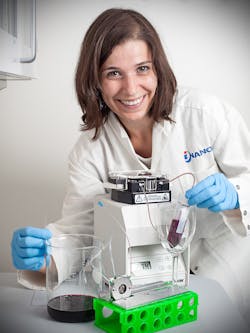Optical biosensor for winemaking has potential for drug development

A novel optical biosensor developed by researchers at the Interdisciplinary Nanoscience Centre (iNANO) of Aarhus University in Denmark could help winemakers control the level of astringency during wine production, as it allows measurement of these levels from the beginning of the process and in real time.
The current technology for measuring astringency is the palate of a professional wine taster—and testing can be done only when a wine has finished its processing. But with the biosensor, winemakers can work towards the desired mouthfeel—the wine's physical and chemical interaction in the mouth—before the wine is ready, which could help wine producers better fine-tune their wines and reduce bad batches. What's more, because the biosensor is capable of measuring these molecule-protein interactions, it could someday have additional utility in developing drugs.
The biosensor uses salivary proteins to measure how the sensation of dryness in wine is experienced when taking a sip, looking at how the proteins change in interacting with the wine. The biosensor, which relies on a spectroscopic technique called localized surface plasmon resonance (LSPR), features a small plate coated with gold nanoparticles. The researchers added the salivary proteins followed by wine to the biosensor's gold-nanoparticled surface, and then directed a beam of light from a UV-VIS-NIR spectrophotometer with wavelengths from 500 to 900 nm onto this surface to yield measurement of the proteins and molecules below the diffraction limit (down to 20 nm). Doing so allowed the researchers to study and follow the salivary proteins' interaction with the wine and measure its effects.
The research team's biosensor—reportedly the first-ever of its kind—not only measures the amount of proteins and molecules in the mouth when drinking wine, but also measures the effect of wine entering the mouth. "We don't want to replace the wine taster. We just want a tool that is useful in wine production. When you produce wine, you know that the finished product should have a distinct taste with a certain level of astringency. If it doesn't work, people won't drink the wine," explains PhD student Joana Guerreiro, who is the first author of the paper that describes the work.1
1. J. R. L. Guerreiro et al., ACS Nano, 8, 8, 7958–7967 (2014); doi:10.1021/nn501962y.
About the Author
Lee Dubay
Managing Editor
Lee Dubay is managing editor for Laser Focus World. She is a seasoned editor and content manager with 20 years of experience in B2B media. She specializes in digital/print content management, as well as website analytics, SEO, and social media engagement best practices.
